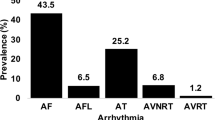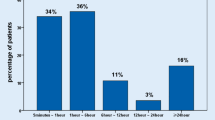Abstract
Some cardiovascular diseases are associated with seasonal or meteorological factors. We tried to identify the relationship between meteorological parameters and the requirement for a permanent pacemaker (PPM) implantation for advanced sinus node dysfunction (SND) and atrioventricular block (AVB). This study enrolled 656 patients (67% male, age = 76 ± 11 years) who underwent a PPM implantation due to SND or AVB from January 2004 to December 2008. Using daily temperature, barometric pressure, humidity, and daylight hour records from Taipei, we evaluated the effect of these meteorological parameters within different time periods on the occurrence of SND and AVB. There were 355 patients in the SND group and 301 in the AVB group. In the AVB group, more patients presented in the spring than in other seasons (P = 0.003). In the SND group, there was no relationship with the seasons (P = 0.137). The proportion of patients with AVB did not depend on the average temperature, barometric pressure, humidity, or daylight hours within 3, 7, and 14 days prior to admission (P = NS). A temperature change of greater than 11°C within 30 days prior to admission was associated with a significantly higher proportion of patients with advanced AVB compared to those with advanced SND (P = 0.009). Extreme change in temperature was the most independent predictor of the development of advanced AVB. The peak occurrence of advanced AVB was in the spring. The occurrence of advanced AVB was associated with extreme temperature changes within 30 days, especially in the spring.


Similar content being viewed by others
References
Arntz HR, Willich SN, Schreiber C, Brüggemann T, Stern R, Schultheiss HP (2000) Diurnal, weekly and seasonal variation of sudden death. Population-based analysis of 24,061 consecutive cases. Eur Heart J 21:315–320
Baboonian C, Davies MJ, Booth JC, McKenna WJ (1997) Coxsackie B viruses and human heart disease. Curr Top Microbiol Immunol 223:31–52
Carlson MD, Wilkoff BL, Maisel WH, Carlson MD, Ellenbogen KA, Saxon LA, Prystowsky EN et al (2006) Recommendations from the Heart Rhythm Society Task Force on Device Performance Policies and Guidelines. Endorsed by the American College of Cardiology Foundation (ACCF) and the American Heart Association(AHA) and the International Coalition of Pacing and Electrophysiology Organizations (COPE). Heart Rhythm 3:1250–1273
Chen CJ, Chen MC, Yip HK, Chang HW, Cheng CI, Chen YH, Chai HT et al (2003) Seasonal distribution of pacemaker implantation for symptomatic bradycardia. Jpn Heart J 44:379–384
Cheng TO (1985) Myocardial infarction and the weather: significant positivecorrelation between the onset of heart infarct and 28KHz atmospherics—a pilot study. Clin Cardiol 8:510
Cooper L Jr (2009) Myocarditis. N Engl J Med 360:1526–1538
De Lorenzo F, Kadziola Z, Mukherjee M, Saba N, Kakkar VV (1999) Haemodynamic responses and changes of haemostatic risk factors in cold-adapted humans. Q J Med 92:509–513
Dilaveris P, Synetos A, Giannopoulos G, Gialafos E, Pantazis A, Stefanadis C (2006) CLimate Impacts on Myocardial infarction deaths in the Athens TErritory: the CLIMATE study. Heart 92:1747–1751
Exindari M, Gioula G, Raptis D, Mavroidi V, Bouzia E, Kyriazopoulou V (2005) Real or media-mediated outbreak of coxsackie infections in 2002 in Greece? Euro Surveil 10:184–187
Feldman AM, McNamara D (2000) Myocarditis. N Engl J Med 343:1388–1398
Hanna JM (1999) Climate, altitude, and blood pressure. Hum Biol 71(4):553–582
Hayward JM, Holmes WF, Gooden BA (1979) Cardiovascular responses in man to a stream of cold air. Cardiovasc Res 10:691–696
Izzo J, Larrabee PS, Sander E, Lillis LM (1990) Hemodynamics of seasonal adaption. Am J Hypertens 3:405–407
Keatinge WR, McIlroy MB, Goldfein A (1964) Cardiovascular responses to ice-cold showers. J Appl Physiol 19:1145–1150
Khan FA, Engstrom G, Jerntorp I, Pessah-Rasmussen H, Janzon L (2005) Seasonal patterns of incidence and case fatality of stroke in Malmö, Sweden: the STROMA Study. Neuroepidemiology 24:26–31
Kreger BE, Anderson KM, Kannel WB (1989) Prevalence of intraventricular block in the general population. The Framingham Study. Am Heart J 117:903–910
Lamas GA, Orav EJ, Stambler BS, Ellenbogen KA, Sgarbossa EB, Huang SK, Marinchak RA, Pacemaker Selection in the Elderly Investigators (1998) Quality of life and clinical outcomes in elderly patients treated with ventricular pacing as compared with dual-chamber pacing. N Engl J Med 338:1097–1104
Lee JH, Chae SC, Yang DH, Park HS, Cho YK, Jun JE, Park WH et al (2010) Influence of weather on daily hospital admissions for acute myocardial infarction (from the Korea Acute Myocardial Infarction Registry). Int J Cardiol 144:16–21
Luderitz B (2002) We have come a long way with device therapy: historical perspectives on antiarrhythmic electrotherapy. J Cardiovasc Electrophysiol 13:S2–S8
Maisch B, Lotze U, Schneider J, Kochsiek K (1986) Antibody to human sinus node in sick sinus syndrome. Pacing Clin Electrophysiol 9:1101–1109
Marchant B, Ranjadayalan K, Stevenson R, Wilkinson P, Timmis AD (1993) Circadian and seasonal factors in the pathogenesis of acute myocardial infarction: the influence of environmental temperature. Br Heart J 69:385–387
Mehta RH, Manfredini R, Hassan F, Sechtem U, Bossone E, Oh JK, Cooper JV et al (2002) Chronobiological patterns of acute aortic dissection. Circulation 106:1110–1115
Minami J, Kawano Y, Ishimitsu T, Yoshimi H (1996) Takishita S (1996) Seasonal variations in office, home and 24 h ambulatory blood pressure in patients with essential hypertension. J Hypertens 14:1421–1425
Morabito M, Modesti PA, Cecchi L, Crisci A, Orlandini S, Maracchi G, Gensini GF (2005) Relationship between weather and myocardial infarction: a biometeorological approach. Int J Cardiol 105:288–293
Morgera T, Di Lenarda A, Dreas L, Pinamonti B, Humar F, Bussani R, Silvestri F et al (1992) Electrocardiography of myocarditis revisited: clinical and prognostic significance of electrocardiographic changes. Am Heart J 124:455–467
Muller JE, Ludmer PL, Willich SN, Tofler GH, Aylmer G, Klangos I, Stone PH (1987) Circadian variation in the frequency of sudden cardiac death. Circulation 75:131–138
Newman D, Lau C, Tang AS, Irvine J, Paquette M, Woodend K, Dorian P et al (2003) CTOPP Investigators. Effect of pacing mode on health-related quality of life in the Canadian Trial of Physiologic Pacing. Am Heart J 145:430–437
Ockene IS, Chiriboga DE, Stanek EJ 3rd, Harmatz MG, Nicolosi R, Saperia G, Well AD et al (2004) Seasonal variation in serum cholesterol levels. Treatment implications and possible mechanisms. Arch Intern Med 164:863–870
Oliveira SA, Camacho LA, Pereira AC, Faillace TF, Setubal S, Nascimento JP (2002) Clinical and epidemiological aspects of human parvovirus B19 infection in an urban area in Brazil (Niterói city area, State of Rio de Janeiro, Brazil). Mem Inst Oswaldo Cruz 97:965–970
Ornato JP, Peberdy MA, Chandra NC, Bush DE (1996) Seasonal pattern of acute myocardial infarction in the National Registry of Myocardial Infarction. J Am Coll Cardiol 7:1684–1688
Raven PB, Wilkerson JE, Horvath SM, Bolduan NW (1975) Thermal, metabolic and cardiovascular responses to various degrees of cold stress. Can J Physiol Pharmacol 53:293–298
Sheth T, Nair C, Muller J, Yusuf S (1999) Increased mortality from acute myocardial infarction and stroke: the effect of age. J Am Coll Cardiol 33:1916–1919
Skagen K, Fischer HJ (1976) The long term prognosis for patients with sinoatrial block treated with permanent pacemaker. Acta Med Scand 199:13–15
Spencer FA, Goldberg RJ, Becker RC, Gore JM (1998) Seasonal distribution of acute myocardial infarction in the second National Registry of Myocardial Infarction. J Am Coll Cardiol 31:1226–1233
Suga T, Akiyoshi K, Haruta T (2008) Analysis of adenoviruses isolated in Kobe City, Japan, from 2000 to 2007. Jpn J Infect Dis 61:503–504
Sugiura M, Okadaka R, Hiraoka K, Ohkawa S (1969) Histological studies the conduction system in 14 cases of right bundle branch block associated with left axis deviation. Jap Heart J 10:121
Takagi T, Okada R (1980) An electrocardiographic-pathologic correlative study on left axis deviation in hypertensive hearts. Am Heart J 100:838–846
Trohman R, Kim M, Pinski S (2004) Cardiac pacing: the state of the art. Lancet 364:1701–1719
Turin TC, Kita Y, Murakami Y, Rumana N, Sugihara H, Morita Y, Tomioka N et al (2008) Higher Stroke Incidence in the Spring Season Regardless of Conventional Risk Factors: Takashima Stroke Registry, Japan, 1988-2001. Stroke 39:745–752
Wang H, Sekine M, Chen X, Kagamimori S (2002) A study of weekly and seasonal variation of stroke onset. Int J Biometeorol 47:13–20
Westheim A, Os I, Thaulow E, Kjeldsen SE, Eritsland J, Eide IK (1992) Haemodynamic and neurohumoral effects of cold pressor test in severe heart failure. Clin Physiol 12:95–106
Acknowledgement
The authors would like to thank the Central Weather Bureau for providing data on meteorological factors.
Author information
Authors and Affiliations
Corresponding author
Electronic supplementary material
Below is the link to the electronic supplementary material.
Table S1
The effect of various meterological factors on pacemaker implantation. (DOC 61 kb)
Rights and permissions
About this article
Cite this article
Liu, IF., Chang, SL., Lo, LW. et al. Relationship between temperature change and the requirement for a permanent pacemaker implantation in bradyarrhythmias. Int J Biometeorol 55, 733–739 (2011). https://doi.org/10.1007/s00484-010-0388-z
Received:
Revised:
Accepted:
Published:
Issue Date:
DOI: https://doi.org/10.1007/s00484-010-0388-z




